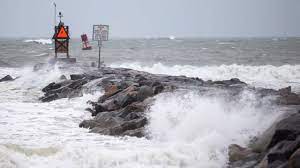
Tropical Storm Ophelia swirled across North Carolina after making landfall near Emerald Isle on Saturday morning, lashing eastern parts of the state with rain, damaging winds and dangerous surges of water.
The storm came ashore with near-hurricane-strength winds of 70 mph (110 kph) at around 6:15 a.m. but would keep weakening as it turns north Saturday and then shifts northeast on Sunday, the U.S. National Hurricane Center said.
Ophelia promises a weekend of windy conditions and heavy rain as it churns up the East Coast. Parts of North Carolina and Virginia can expect up to 7 inches of rain (18 centimeters), with 2 to 4 inches (5 to 10 centimeters) forecast in the rest of the mid-Atlantic region through Sunday.
Philippe Papin, a hurricane specialist with the National Hurricane Center, said the primary risk of the storm system over the next couple of days will be the threat of floods from the rain.
“There have been tropical storm-force winds observed, but those are starting to gradually subside as the system moves further inland,” Papin said in an interview early Saturday. “However, there is a significant flooding rainfall threat for a large portion of eastern North Carolina into southern Virginia over the next 12 to 24 hours.”
“When you have that slow-moving storm with several inches of rain, coupled with a gust that gets to 30, 40 miles per hour, that’s enough to bring down a tree or to bring down limbs,” Duke Energy spokesperson Jeff Brooks told WTVD-TV on Saturday. “And that’s what we’ve seen in most of the areas where we’ve experienced outages.”
A storm surge warning, indicating danger from rising ocean water pushed inland by Ophelia, was in effect from Bogue Inlet, North Carolina, to Chincoteague, Virginia. Surges between 4 and 6 feet (1.2 and 1.8 meters) were forecast in some areas. A tropical storm warning was issued from Cape Fear, North Carolina, to Fenwick Island, Delaware.
The governors of North Carolina, Virginia and Maryland each declared a state of emergency on Friday. Some schools closed early and several weekend events were canceled. In Washington, the Nationals baseball team postponed its Saturday game until Sunday. The North Carolina Ferry System has suspended service on all routes until conditions improve.
Nancy Shoemaker and her husband Bob stopped to pick up sandbags on Friday in a park in Maryland’s capital, Annapolis. A surge of water during a storm last October washed away sandbags they put in their yard, which is right next to the water.
“We’re hoping it won’t be that way this time,” Nancy Shoemaker said. “If we have a lot of wind and a lot of surge, it can look like the ocean out there, so that’s a problem.”
It is not uncommon for one or two tropical storms, or even hurricanes, to develop right off the East Coast each year, National Hurricane Center Director Michael Brennan said.
“We’re right at the peak of hurricane season, we can basically have storms form anywhere across much of the Atlantic basin,” Brennan said in an interview Friday.
Scientists say climate change could result in hurricanes expanding their reach into mid-latitude regions more often, making storms like this month’s Hurricane Lee more common.
One study simulated tropical cyclone tracks from pre-industrial times, modern times and a future with higher emissions. It found that hurricanes would track closer to the coasts including around Boston, New York and Virginia and be more likely to form along the Southeast coast.
___
AP Radio reporter Jackie Quinn in Washington and AP writer Jonathan Mattise in Nashville, Tennessee contributed.






